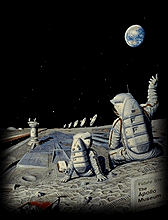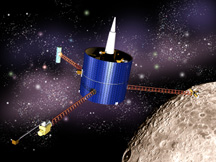Water on the Moon?
News story originally written on March 10, 1998
The tiny Lunar Prospector probe launched in January 1998 has found the answer to the most controversial question in lunar science. The Lunar Prospector has found that there is indeed water-ice located at the poles of the Moon. This finding, made just days ago, is certainly a historical discovery!The Prospector is piggy-backing on the work done earlier by Clementine in 1994. Clementine, a lunar probe built by the Pentagon, first indicated the possibility of ice on the Moon. Now, just four years later, scientists are claiming Prospector's findings of ice as unquestionably true.
Prospector has found between 10 and 300 million tons of water-ice located at the North and South poles of the Moon. This water-ice probably accumulated as meteors and comets (both containing water) hit the Moon's surface.
You might find yourself saying, "So what! We have plenty of water here on Earth!" But the fact that we've found sources of water on the Moon makes the possibility of a lunar colony so much more feasible. You see, transporting water to the Moon to support the men and women who would live there would be very expensive - an estimated $10,000 per pound of water! The amount of water-ice that the Prospector predicts is present on the Moon could support a community of 1,000 two-person households for well over a century on the lunar surface, without recycling.
"This spacecraft has performed beyond all reasonable expectations," said NASA's Lunar Prospector mission manager Scott Hubbard. "The findings announced today are just the tip of the iceberg compared to the wealth of information forthcoming in the months and years ahead."















